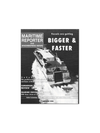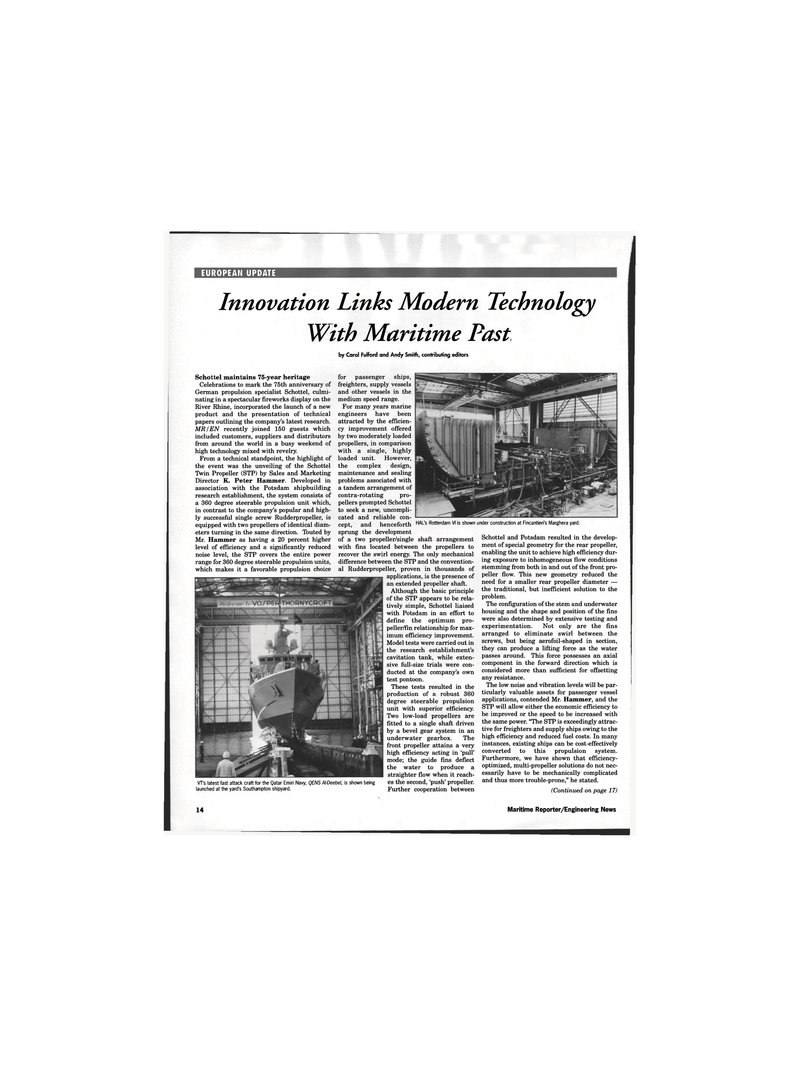
Page 12: of Maritime Reporter Magazine (October 1996)
Read this page in Pdf, Flash or Html5 edition of October 1996 Maritime Reporter Magazine
EUROPEAN UPDATE
Innovation Links Modern Technology
With Maritime Past by Carol Fulford and Andy Smith, contributing editors
Schottel maintains 75-year heritage
Celebrations to mark the 75th anniversary of
German propulsion specialist Schottel, culmi- nating in a spectacular fireworks display on the
River Rhine, incorporated the launch of a new product and the presentation of technical papers outlining the company's latest research.
MR/EN recently joined 150 guests which included customers, suppliers and distributors from around the world in a busy weekend of high technology mixed with revelry.
From a technical standpoint, the highlight of the event was the unveiling of the Schottel
Twin Propeller (STP) by Sales and Marketing
Director K. Peter Hammer. Developed in association with the Potsdam shipbuilding research establishment, the system consists of a 360 degree steerable propulsion unit which, in contrast to the company's popular and high- ly successful single screw Rudderpropeller, is equipped with two propellers of identical diam- eters turning in the same direction. Touted by
Mr. Hammer as having a 20 percent higher level of efficiency and a significantly reduced noise level, the STP covers the entire power range for 360 degree steerable propulsion units, which makes it a favorable propulsion choice
VT's latest fast attack craft for the Qatar Emiri Navy, QENS Al-Deebel, is shown being launched at the yard's Southampton shipyard. for passenger ships, freighters, supply vessels and other vessels in the medium speed range.
For many years marine engineers have been attracted by the efficien- cy improvement offered by two moderately loaded propellers, in comparison with a single, highly loaded unit. However, the complex design, maintenance and sealing problems associated with a tandem arrangement of contra-rotating pro- pellers prompted Schottel to seek a new, uncompli- cated and reliable con- cept, and henceforth sprung the development of a two propeller/single shaft arrangement with fins located between the propellers to recover the swirl energy. The only mechanical difference between the STP and the convention- al Rudderpropeller, proven in thousands of applications, is the presence of an extended propeller shaft.
Although the basic principle of the STP appears to be rela- tively simple, Schottel liaised with Potsdam in an effort to define the optimum pro- peller/fin relationship for max- imum efficiency improvement.
Model tests were carried out in the research establishment's cavitation tank, while exten- sive full-size trials were con- ducted at the company's own test pontoon.
These tests resulted in the production of a robust 360 degree steerable propulsion unit with superior efficiency.
Two low-load propellers are fitted to a single shaft driven by a bevel gear system in an underwater gearbox. The front propeller attains a very high efficiency acting in 'pull' mode; the guide fins deflect the water to produce a straighter flow when it reach- es the second, 'push' propeller.
Further cooperation between
HAL's Rotterdam VI is shown under construction at Fincantieri's Marghera yard.
Schottel and Potsdam resulted in the develop- ment of special geometry for the rear propeller, enabling the unit to achieve high efficiency dur- ing exposure to inhomogeneous flow conditions stemming from both in and out of the front pro- peller flow. This new geometry reduced the need for a smaller rear propeller diameter — the traditional, but inefficient solution to the problem.
The configuration of the stem and underwater housing and the shape and position of the fins were also determined by extensive testing and experimentation. Not only are the fins arranged to eliminate swirl between the screws, but being aerofoil-shaped in section, they can produce a lifting force as the water passes around. This force possesses an axial component in the forward direction which is considered more than sufficient for offsetting any resistance.
The low noise and vibration levels will be par- ticularly valuable assets for passenger vessel applications, contended Mr. Hammer, and the
STP will allow either the economic efficiency to be improved or the speed to be increased with the same power. "The STP is exceedingly attrac- tive for freighters and supply ships owing to the high efficiency and reduced fuel costs. In many instances, existing ships can be cost-effectively converted to this propulsion system.
Furthermore, we have shown that efficiency- optimized, multi-propeller solutions do not nec- essarily have to be mechanically complicated and thus more trouble-prone," he stated. (Continued on page 17) 14 Maritime Reporter/Engineering News

 11
11

 13
13
